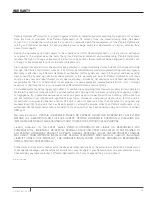
9
E-03-601 (02-15-22)
RISK OF FIRE OR EXPLOSION.
Do not smoke or
use open flames in or around this system. Only the FM listed
products are to be used in a hazardous location applications
per NFPA 70 National Electric Code. Do not pump flammable
liquids. Do not use non-hazardous duty rated pumps in explosive
environments.
CUTTING RISK.
Risk of serious cutting or
amputation exists. Always keep fingers and hands away from
cutting profiles. Disconnect all power sources prior to servicing
pump. Pump may start without warning. Use caution as liner
plate is extremely sharp.
PUMP OPERATIONS STARTING SYSTEM
1. Double check all wire connections.
2. Turn pumps to Off position on H-O-A switches.
3. Turn on breakers.
4. Connect amprobe to pump power cord and turn pump on. The
pump will show high amp draw momentarily, then as pump
comes off start wirings, amps will drop to normal nameplate
amps.
5. When using three phase pumps (208/230/460/575), turn
the H-O-A switch to Hand position on one pump and notice
operation. If pump is noisy and vibrates, rotation is wrong.
To change rotation, interchange any two line leads to pump.
Do not interchange main incoming lines. Check rotation of
all pumps in this same manner.
6. Now set both H-O-A switches to Auto position and allow
water to rise in sump until one pump starts. Allow pump to
operate until the level drops to turn-off point.
7. Allow sump level to rise to start other pump(s). Notice run
lights in panel. Pumps should alternate on each successive
cycle of operation.
8. Turn both H-O-A switches to Off position and allow sump to
fill to the override control level(s).
9. Turn switches to Auto position, and pumps should start and
operate together until level drops to turn-off point.
10. Repeat this operation and cycle several times before
leaving the job.
11. Check voltage when pumps are operating and check
the amp draw of each pump. Check amps on each pump
conductor as sometimes a high leg will exist. For excessive
voltage on one leg, the electric utility company should be
consulted.
PUMP MAINTENANCE
As the motors are oil filled, no lubrication or other maintenance is
required.
If the heat sensor and seal failure are hooked up properly, no
attention is necessary as long as the seal failure indicator light
does not come on. To ensure continuity of the seal sensor leads
on hazardous duty rated pumps only, a test light is provided on
intrinsically safe panels as standard equipment.
Before handling these pumps and controls,always
disconnect the power first. Do not smoke, use flames or devices
that can produce electrical discharge or sparks in a septic
(gaseous) or possible septic sump.
FIELD SERVICE ON ORDINARY LOCATION PUMPS
Ordinary location submersible motors that are out of warranty
can be serviced in the field by any reliable motor service shop.
Any pump that is in warranty must be returned to the factory for
service or repaired at an authorized service center. Charges will
not be allowed if (in warranty) pump is not taken to an authorized
service center. When field service is performed on a pump,
these instructions should be carefully followed.
FIELD SERVICE ON HAZARDOUS LOCATION PUMPS
Hazardous location pumps must be returned to the factory for
electrical and motor service. Any repair not at an authorized
service center will void the Factory Mutual (FM) listing. This
will ensure the integrity of the hazardous location rating of the
pump and comply with our warranty requirements.
The cord assembly, cartridge seal, volute and impeller
components may be repaired or replaced by an authorized
service facility without compromising the hazardous location
rating to the pump.
For any repairs in which the oil is drained, the pump must be
re-filled with an approved oil. The motor chamber cannot be
disassembled, during repairs as this will result in loss of agency
rating.
Any time a seal is disturbed, it must be replaced.
Check the pump for proper rotation before returning to service.
OPERATIONS & MAINTENANCE






































